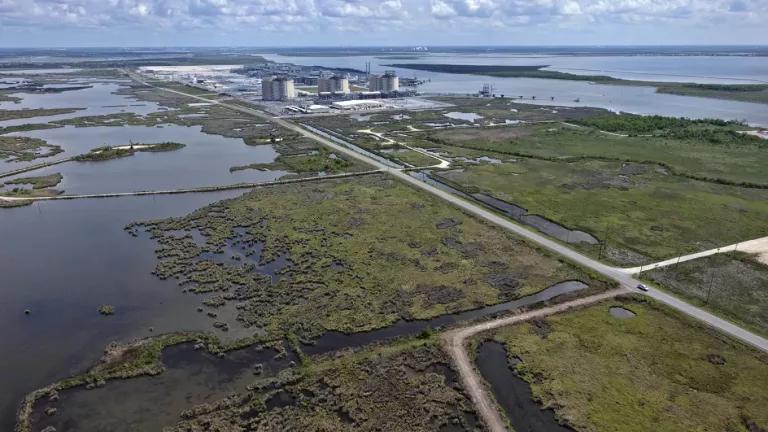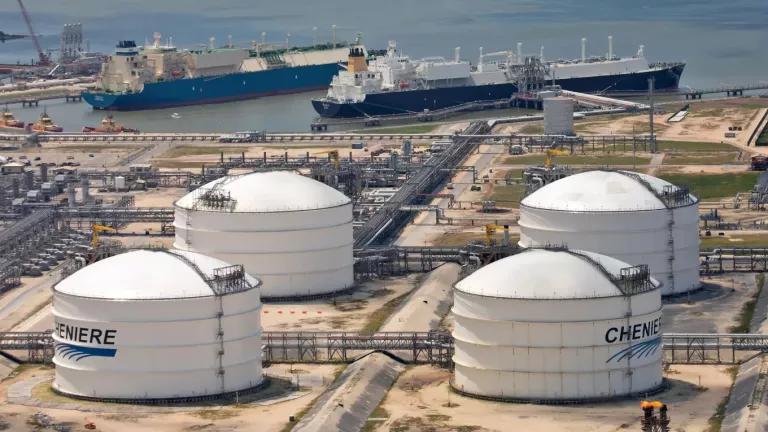What Does the Commonwealth Case Mean for U.S. Gas Policy?
A key legal challenge, in context.

Wetlands near the Cameron liquefied natural gas export terminal along the Calcasieu Channel in Hackberry, Louisiana
Credit: Julie Dermansky for NRDC
In recent years, the U.S. has overtaken all other countries to become the world’s largest exporter of natural gas. It’s an achievement that has helped energy companies book massive profits, but it comes at an alarming cost to the environment and public health. Expanding and promoting the use of gas abroad radically undermines U.S. climate goals, including a promise to transition away from fossil fuels, and poses serious health risks to communities already suffering from the impacts of energy development.
Even worse, the U.S. has reached this troubling milestone without guidelines to assess the full impact from producing, shipping, and burning gas on our climate or public health. In January, the Biden administration took the first step in addressing these impacts by pausing the permitting of new liquified natural gas (LNG) export facilities until the Department of Energy (DOE) can review whether such projects are in the public interest of Americans.
But while the DOE takes the time to evaluate the criteria for exports, LNG infrastructure already in the approval process are not going away. And the challenge to one such project is coming up for oral arguments before a federal court of appeals.
In 2022, the Federal Energy Regulatory Commission (FERC) approved the Commonwealth LNG export terminal proposed for Louisiana without determining if the project actually serves the public interest. In a challenge scheduled to be heard before the D.C. Circuit Court on February 12, NRDC and others argue that FERC broke the law and that the court must revoke Commonwealth LNG’s permit.
If it becomes operational, the Commonwealth LNG export terminal located on the west bank of the Calcasieu Ship Channel at the mouth of the Gulf of Mexico near Cameron, Louisiana will have the capacity to ship 9.3 million tons of LNG a year. The project includes a three-mile pipeline to bring in gas from two pipeline systems and is proposed to open in 2027.
FERC’s decision to approve Commonwealth LNG is a stark example of how the lack of clear guidance undermines regulators charged with weighing the merits of gas projects. In its review, FERC found that Commonwealth LNG would emit more than 100 million tons of carbon dioxide over 30 years causing $3.6 billion in societal harm, yet the agency stopped short of determining whether those emissions were significant.
“By refusing to determine whether the Terminal’s greenhouse gas emissions were significant, FERC both compromised consideration of potential mitigation and deprived the public of the informed, transparent decision making” the law requires, NRDC said in a brief challenging the project.
The law requires FERC and DOE both to find that export projects are in the public interest before granting permits. Yet for years, the agencies have charged ahead approving projects in the absence of guidelines to help them assess climate and public health impacts. Since 2012 when the DOE began approving export permits, it has never rejected an application over the public interest requirement while FERC has approved nearly every pipeline and LNG terminal application it has received since 1999.
Meanwhile, communities in the shadow of gas infrastructure, such as Port Arthur, Texas (one of the poorest cities in Texas), say their concerns over displacement, pollution, and climate change have been ignored. In the case of Commonwealth LNG, FERC noted that the project would increase levels of nitrogen dioxide, a gas that can reduce lung function, aggravate asthma, and increase emergency room visits. But FERC failed to account for the cumulative impact of emissions in low-income and minority environmental justice communities.
Determined lobbying by community groups on the frontlines of the climate crisis has helped move the needle. In 2022, FERC issued a revised Certificate Policy Statement that properly assessed impacts on climate, communities, and markets. FERC also issued an interim Greenhouse Gas Policy Statement to broaden its framework for evaluating climate impacts. It was hoped these measures would bring FERC into compliance with the law and ensure that climate and environmental justice mattered.
Sadly, after industry pushback, both initiatives were reverted to draft status and have yet to be finalized.
That’s especially troubling for Louisiana which is undergoing a massive buildout of LNG infrastructure. Along with Commonwealth LNG, Venture Global, a Virginia-based company already building an LNG terminal in the state, is planning another project called CP2 that would ship a staggering 24 million tons of gas a year, making it the largest proposed export terminal in the Gulf of Mexico. The project is awaiting final approval from FERC.
The Biden administration’s pause on approving new LNG exports is a long-overdue step in the right direction, especially when you consider that methane, the main component of LNG, is a greenhouse gas 80 times more potent than carbon dioxide. The unfettered expansion of U.S. gas production, driven by LNG exports, will restrict or eliminate any path for the U.S. to meet near and long-term climate goals. Commonwealth LNG and other projects being pushed by the industry are among the largest new sources of carbon emissions in the world. FERC must take it upon itself to institute the same level of review as DOE is considering. Until then, courts will need to hold FERC accountable to the law.





